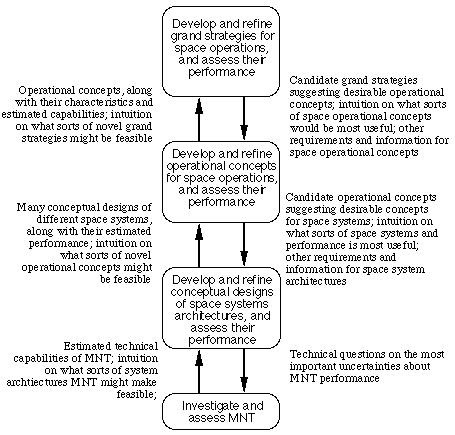While this larger methodology is expressed in terms of a focus on space operations, it could be useful in all application areas for MNT. The methodology is based on a hierarchy of technical capabilities, system architectures, operational concepts, and grand strategies.
MNT will make dramatically improved systems possible, and it thus is important to develop and analyze system concepts using MNT [4]. Such systems must be evaluated in their operating context. MNT will so change the total environment of capabilities and actions, however, that it will transform the operating environment context for doing the analysis. This "chicken-and-egg" problem requires an iterative analysis methodology to resolve.
Figure 2 describes such an iterative process, built around the hierarchy of technical capabilities, system architectures, operational concepts, and grand strategies. Each level provides building blocks for assembling concepts at the level above. Thus, one can think synthetically, combining building blocks into concepts at the next higher level. Also, one can think holistically, using an intuition or theory about what MNT can achieve at a particular level to develop a concept at that level. In this latter case, one must then do a top down analysis to make sure that the lower levels can actually support this new concept, resulting in either a refutation or added confidence in the concept. Another result of this top-down analysis likely to be additions to the menu of building blocks at the levels below.
A first step in this methodology is to take a broad range of previously defined system architectures, and apply the Technical Performance Parameters of MNT to those architectures. This will provide an initial set of MNT-based system architectures from which to launch further analysis. Such system architectures are likely to be unbalanced, however, and thus will probably perform significantly less well than system architectures designed to exploit the particular capabilities of MNT. The research is this paper is part of that first step.

No comments:
Post a Comment